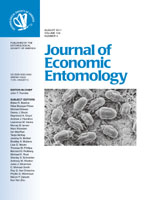Although potato leafhopper, Empoasca fabae (Harris) (Hemiptera: Cicadellidae), is highly polyphagous, classic host studies do not recognize grapevines (Vitis spp.), as suitable hosts. Recently, injury has been reported and reproduction documented within grape vineyards, suggesting a host expansion for the leafhopper. To document this apparent expansion in host use, we determined whether grape plants were suitable hosts for potato leafhopper reproduction, measured the consequence of feeding injury on gas exchange rates of grape leaves, and compared the susceptibility to feeding injury among cultivars. We found that potato leafhopper adults survived equally well on grape (Vitis vinifera L.), alfalfa (Medicago sativa L.), and fava bean (Vicia faba L.). The total number of offspring was greater on fava bean but did not differ between alfalfa and grape. Injury to grapevines was assessed by measuring gas exchange responses of leaves in field cages and in greenhouse tests. We found marginally significant declines in photosynthesis and transpiration rates in the field (9.6 and 13.2%, respectively), and much stronger effects in greenhouse tests (ranging between 22 and 52%). Our results verify that Vitis is a suitable host, and that potato leafhopper is capable of injuring its gas exchange physiology. We discuss possible explanations for the host expansion, and its potential to damage commercial grapevines.
How to translate text using browser tools
1 August 2011
Host Suitability and Gas Exchange Response of Grapevines to Potato Leafhopper (Hemiptera: Cicadellidae)
William O. Lamp,
Daniel Miranda,
Lauren E. Culler,
Laurie C. Alexander
ACCESS THE FULL ARTICLE
It is not available for individual sale.
This article is only available to subscribers.
It is not available for individual sale.
It is not available for individual sale.

Journal of Economic Entomology
Vol. 104 • No. 4
August 2011
Vol. 104 • No. 4
August 2011
Empoasca fabae
host plant expansion
photosynthesis
transpiration




